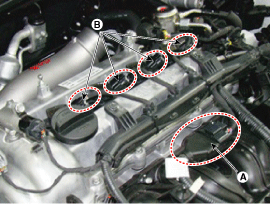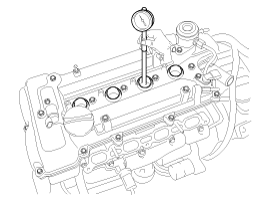Hyundai Sonata LF: General Information / Repair procedures
| Compession Pressure Inspection |
If the there is lack of power, excessive oil consumption or poor fuel economy, measure the compression pressure. |
| 1. |
Make sure the oil in the crankcase is of the correct
viscosity and at the correct level and that the battery is correctly
charged. Operate the vehicle until the engine is at normal operating
temperature. Turn the ignition switch to the OFF position. |
| 2. |
Remove the engine cover. |
| 3. |
Disconnect the injector extension connector (A) and the ignition coil connectors (B).
|
| 4. |
Remove the ignition coils (A).
|
| 5. |
Remove the spark plugs.
Using a 16mm plug wrench, remove the 4 spark plugs. |
| 6. |
Check the cylinder compression pressure.
|
| 7. |
Install the spark plugs.
|
| 8. |
Install the ignition coil.
|
| 9. |
Connect the injector extension connector and the ignition coil connectors. |
| 10. |
Install the engine cover. |
 Specifications
Specifications
Specifications DescriptionSpecificationsLimitGeneralTypeIn-line, DOHC?Number of cylinders4?Bore77mm (3.0315in)?Stroke85.44mm (3.3638in)?Total displacement1,591 cc (97...
 Troubleshooting
Troubleshooting
Troubleshooting SymptomSuspect areaRemedyEngine misfire with abnormal internal lower engine noises.Loose or improperly installed engine flywheel.Repair or replace the flywheel as required...
Other information:
Hyundai Sonata LF 2014-2019 Service Manual: Trailing Arm Repair procedures
Replacement 1. Raise the vehicle, and make sure it is securely supported. 2. Remove the wheel cap (A). Be careful not to damage to the wheel cap (A) when removing the it. 3. Remove the front wheel and tire (A) from front hub...
Hyundai Sonata LF 2014-2019 Service Manual: Lift And Support Points
General Information When heavy rear components such as suspension, fuel tank, spare tire, tailgate and trunk lid are to be removed, place additional weight in the luggage area before hoisting. When substatial weight is removed from the rear of the vehicle, the center of gravity may change and can cause the vehicle to tip forward on the hoist...
Categories
- Manuals Home
- Hyundai Sonata Owners Manual
- Hyundai Sonata Service Manual
- Lighting System
- Fuel Delivery System
- Air Conditioning System
- New on site
- Most important about car




